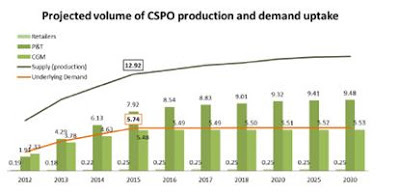Back in 2010, Khor Reports first highlighted the
problem of a structural demand deficit at the RSPO. The latest supply and
demand forecast from the voluntary sustainability certification organisation
suggests that supply is set to continue exceeding demand by a factor of two for
the foreseeable future ie. market uptake for CSPO may remain at about 50
percent, even during the 2015-2030 period.
RSPO publishes key data from its members for the first
time
The RSPO requires that its members report on both their
progress and their future commitments on sustainability. In its “Annual
Communications of Progress” (ACOP) effort for 2011/12, the RSPO has made a good
effort to offer crucial insights into the future supply and demand for its
sustainability program. For the growers, this means they need to report
annually on key items such as planted area, new planting area, and third party
fresh fruit bunch (FFB) sourcing. For consumer goods manufacturers (CGMs) and
retailers, they need to report on volume of palm oil products sold in own-brand
products. Crucially, all have to report on their time-bound plan (TBP) or year
to achieve their respective 100% implementation of RSPO certification.
Future market uptake of CSPO may range 40-62%
By the RSPO’s reckoning, market uptake may only be 44%
in 2015, subsequently drifting down to 39% in 2020 and 38% in 2030. This
forecast is based on a relatively conservative “underlying demand” which
comprises commitments based on current usage by CGMs (includes key users of palm
oil such as Unilever and Nestle as well as big bio-diesel providers such as
Neste Oil) and retailers (including the likes of Wal-mart and Tesco, with
significant own-brand products businesses). For fear of double-counting, this
demand forecast excludes volumes from the processors and traders category
(whose members include Wilmar and Cargill), since they are supply-chain
providers to the aforementioned groups and no detailed information was sought
on volumes for their own end-product usage, which includes cooking oil and
animal feed.
Source: RSPO
On a more optimistic measure, based on commitments by
processors & traders, demand could rise to 7.92, 9.32 and 9.48 million MT
in 2015, 2020 and 2030; resulting in market uptake of about 62% for 2015
through 2030.
Taking the average of the more conservative and more
optimistic demand forecasts, the outlook is for 51% market uptake for the
period 2015 to 2030. Thus, the RSPO concludes in its October 2012 report that
“the current pattern of only about half of available CSPO being consumed may
persist unless more manufacturer and retailer members of the RSPO make
commitments to use it on the supply-side…. the RSPO needs to work harder to
increase the number of CGMs, including as yet non-members who are committing to
use CSPO as well as far harder at promoting CSPO amongst companies that are not
yet members. In particular, markets outside of Europe and the US need to start
demanding CSPO if the projected supply is going to be matched by demand.”
Structural oversupply
This lacklustre outlook is despite the good effort of
RSPO in rapidly expanding members in the CGM and retailer categories in the
last two years and pushing for 100 percent global procurements from them by
2015. The effort of the WWF's buyers’ scorecard (to pressure CGMs) has been
quite instrumental in this regard too. RSPO is the brainchild of the WWF.
The forecasted demand deficit therefore appears to be
a structural problem. We think it is a result of two factors.
First, the highly concentrated industry structure in the
global palm oil growing sector clearly exceeds that of the global CGM industry.
Unilever, with 1.3 million MT of palm oil usage each year, has played a key
lead role in the RSPO. Subsequently RSPO has signed on many others. It is hard
to think of a big global brand who is not a member. However, the commitments
from nearly all the big global brands are insufficient to mop up supply of RSPO
sustainable certificates from the growers. This sector is highly concentrated
with 85 percent global supply from Indonesia and Malaysia where very large
corporate growers have a big market share. In Indonesia alone, there are five
(5) groups whose individual annual production of palm oil are close to or
significantly exceed Unilever’s tonnage. Big growers are key contributors to
the RSPO. Small estates and smallholders have been left out of the
certification game (apparently unless receiving exceptionable financial and/or
non-financial support).
Second, the RSPO requires 100 percent of a grower’s
area to be certified. It is therefore designed to disregard market demand. This
is in contrast to the Roundtable on Sustainable Soy (RTRS), the certification
for soy, the key competitor of palm oil. Here, the WWF and Unilever also play
key roles. RTRS members, while having to abide by some key universal
principles, are free to decide how much of their area should be certified.
The RSPO
therefore faces the challenge of boosting demand for sustainable palm oil,
beyond the global brand names and in the face of "palm oil free" challenges
in its key EU market.

